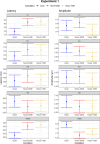Effects of stimuli and contralateral noise levels on auditory cortical potentials recorded in school-age children
- PMID: 39841711
- PMCID: PMC11753713
- DOI: 10.1371/journal.pone.0317661
Effects of stimuli and contralateral noise levels on auditory cortical potentials recorded in school-age children
Abstract
Background and objective: One of the functions attributed to the auditory efferent system is related to the processing of acoustic stimuli in noise backgrounds. However, clinical implications and the neurophysiological mechanisms of this system are not yet understood, especially on higher regions of the central nervous system. Only a few researchers studied the effects of noise on cortical auditory evoked potentials (CAEP), but the lack of studies in this area and the contradictory results, especially in children, point to the need to investigate different protocols and parameters that could allow the study of top-down activity in humans. For this reason, the aim of this study was to analyze the effect of varying levels of contralateral noise on efferent activity in children by recording CAEPs with tone burst stimuli. Additionally, we aimed at verifying the effects of contralateral noise on cortical processing of speech stimuli.
Methods: Monaural CAEPs were recorded using tone burst stimuli in quiet and with contralateral white noise at 60 dB and at 70 dB in 65 typically developing school-aged children (experiment 1), and using speech stimuli with contralateral white noise at 60 dB in 41 children (experiment 2).
Results: In experiment 1, noise induced changes were observed only for P1 and P300 components. P1 latency was prolonged at both noise level conditions, P300 latency was prolonged only in the condition with noise at 70 dB, and P300 amplitude was reduced only in the condition with noise at 60 dB. In experiment 2, noise induced latency delays were observed on P1, P2, N2, and P300 components and amplitude reduction was observed only for N1.
Conclusion: The effects of noise stimulation were observed on all CAEP components elicited by speech, but the same was not observed in the experiment with tone bursts. The study of noise effects on CAEPs can provide electrophysiological evidence on how difficult listening situations affect sound discrimination and stimulus evaluation at thalamocortical regions.
Copyright: © 2025 Ubiali et al. This is an open access article distributed under the terms of the Creative Commons Attribution License, which permits unrestricted use, distribution, and reproduction in any medium, provided the original author and source are credited.
Conflict of interest statement
The authors have declared that no competing interests exist.
Figures







Similar articles
-
Dynamics of infant cortical auditory evoked potentials (CAEPs) for tone and speech tokens.Int J Pediatr Otorhinolaryngol. 2013 Jul;77(7):1162-73. doi: 10.1016/j.ijporl.2013.04.030. Epub 2013 May 27. Int J Pediatr Otorhinolaryngol. 2013. PMID: 23722003 Free PMC article.
-
The Effect of Signal to Noise Ratio on Cortical Auditory-Evoked Potentials Elicited to Speech Stimuli in Infants and Adults With Normal Hearing.Ear Hear. 2018 Mar/Apr;39(2):305-317. doi: 10.1097/AUD.0000000000000487. Ear Hear. 2018. PMID: 28863034
-
Varying effect of noise on sound onset and acoustic change evoked auditory cortical N1 responses evoked by a vowel-vowel stimulus.Int J Psychophysiol. 2020 Jun;152:36-43. doi: 10.1016/j.ijpsycho.2020.04.010. Epub 2020 Apr 14. Int J Psychophysiol. 2020. PMID: 32302643
-
[Correlation between Mandarin acceptable noise level and cortical auditory evoked potential in young normal-hearing listeners].Lin Chuang Er Bi Yan Hou Tou Jing Wai Ke Za Zhi. 2022 Sep;36(9):679-684. doi: 10.13201/j.issn.2096-7993.2022.09.006. Lin Chuang Er Bi Yan Hou Tou Jing Wai Ke Za Zhi. 2022. PMID: 36036068 Free PMC article. Chinese.
-
A systematic review of acoustic change complex (ACC) measurements and applicability in children for the assessment of the neural capacity for sound and speech discrimination.Hear Res. 2024 Sep 15;451:109090. doi: 10.1016/j.heares.2024.109090. Epub 2024 Jul 17. Hear Res. 2024. PMID: 39047579
References
MeSH terms
LinkOut - more resources
Full Text Sources
Medical
Miscellaneous

